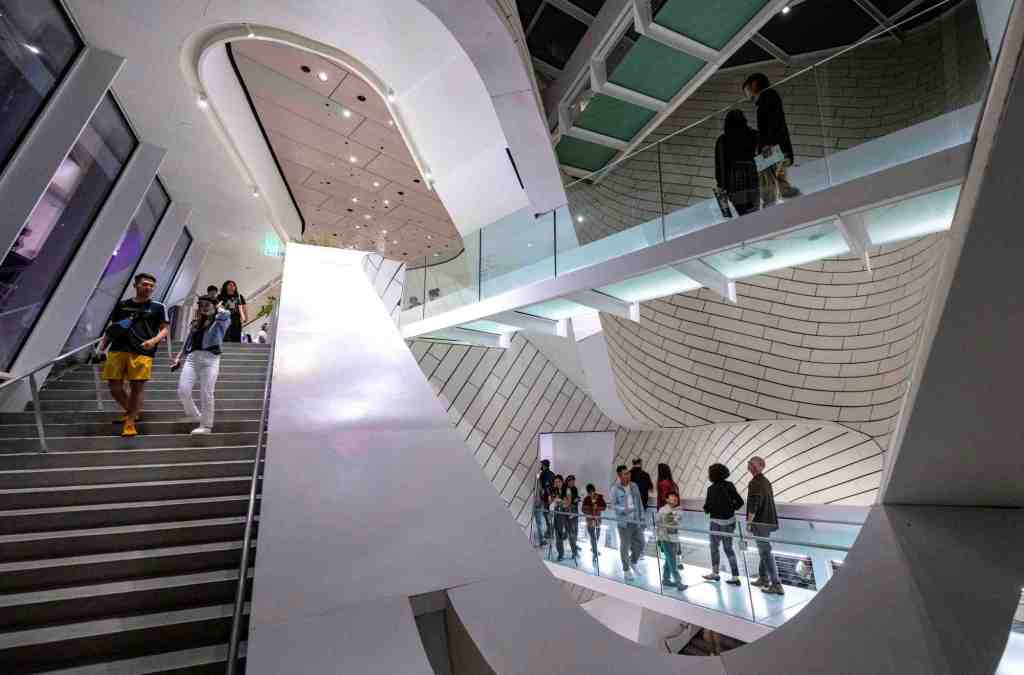
UC Irvine is formally taking control of the Orange County Museum of Art, a move that could turn the museum into a more vibrant hub for art-curious visitors and a new place to study and create for art students.
School officials confirmed the deal Monday, Sept. 29, saying the first change will be a new name: UC Irvine Langson Orange County Museum of California Art. Other changes, including figuring out how to display a now 9,000-piece combined collection, hiring a new museum director and incorporating the museum’s gallery and studio space into UCI’s fine art program, are expected to play out over the next year.
While UCI and different leaders of the 63-year-old museum – which opened its new location at the Segerstrom Center for the Arts in October 2022 – have, over the decades, held informal talks about joining forces, the idea gained steam earlier this year.
In April, the museum’s director, Heidi Zuckerman, announced that she will leave the organization when her contract ends in December. By June, officials from the school and the museum said merger talks were underway and a deal was likely. That was finalized earlier this month, when the UC Board of Regents approved the idea, allowing UCI to go forward.
No money is expected to change hands and a philanthropic commitment to keep the Orange County Museum’s admission free for 10 years remains in place.
For UCI, merging with the local museum – something universities have done in Los Angeles, Chicago and New York, among other cities – is part of a broader push to be a more visible player in the county’s daily life. That effort has included everything from stepped-up political polling by UCI’s School of Social Ecology to the creation of a 144-bed medical center – UCI Health, Irvine Acute Care Hospital – set to open this year.
UC Irvine Chancellor Howard Gillman, in a prepared statement, suggested UCI’s takeover of the museum is aimed at helping both residents and students:
“UC Irvine is committed to ensuring that the region benefits from a world-class art museum that enriches the cultural fabric of Orange County, advances groundbreaking scholarship, nurtures the next generation of creators and thinkers, and inspires curiosity and connection across diverse audiences.”
The move also could save UCI some money.
For several years, UCI has been asking donors for funds – roughly $2 billion to date – to finance a range of construction projects on campus. A new art museum, which could cost $100 million or more, has been part of that request. Now, that expense goes away, with UCI gaining control of the modern, 53,000-square-foot art facility at the Segerstrom Center for the Arts.
Another element of the merger is its potential to boost UCI’s fine art program.
Though better known for hard sciences and computer engineering, among other fields, UCI has a strong history as an art school.
British artist David Hockney and 20th-century California painters such as Ed Moses and Robert Irwin have taught at UCI. And the late conceptual artist, Chris Burden, and still-active light and space artist James Turrell have ties to the school as students and instructors. In 1971, the year he received an MFA from UCI, Burden made international headlines for his performance piece “Shoot,” in which he was intentionally shot (through the arm) while on display at an art gallery in Santa Ana as a way to express America’s obsession with gun violence.
In recent years, the school has become known for merging technology and fine art and for an expanding art history program. About 200 students currently study fine art at UCI, and school officials said it’s likely the merger with the county’s biggest museum will be a talking point in recruiting future students.
For the museum, the deal provides something it has tasted only recently: long-term stability.
The museum was founded in 1962 on Balboa Island, and bounced among several locations over the decades. It has grown in recent years and has a strong collection of 20th and 21st-century paintings, including many that represent different iterations of California art.
The 2022 move to its current home, near South Coast Plaza, was widely viewed as a chance to raise the museum’s reputation and solidify its role as a place to be entertained and challenged by art. One of its shows this year – “I Don’t Want to Grow Up,” by Japanese sculptor and painter Yoshitoma Nara – reflects the museum’s increasing international reach.
The merger with UCI might make the museum more attractive for donors interested in giving away their art.
The deal still leaves some questions unanswered. Officials at UCI said the search for a new museum director remains underway, and that they hope to have someone in place by early next year.
“The big difference now is that the new director will be leading the transition to combine both entities,” said school spokesman Mike Uhlenkamp.
The merger doesn’t immediately close UCI’s existing museum, at least for now. The Gerald Buck Collection and Irvine Museum Collection will continue to be displayed at a leased site in Irvine, and it’s unclear if those pieces will be displayed at the new museum when that lease ends, sometime next year.
Also, the Jack and Shanaz Langson Institute of Art – which emphasizes art research and offers student training independent of UCI – will continue. Currently, the institute is located with UCI’s museum, at a site on Von Karman Avenue, but it’s expected to move, possibly on campus, when that lease ends.
For now, the two museums – UCI Langson Museum of Art and the Orange County Museum of Art – will share a website. That is expected to change as the merger comes together over the next year.



